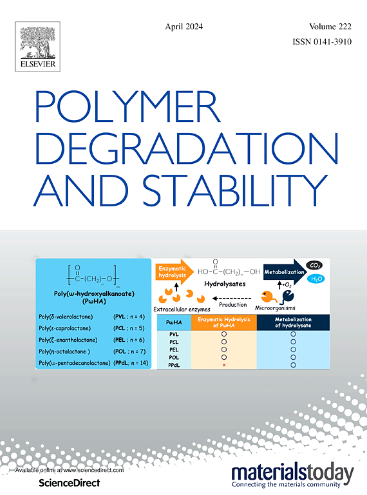环氧树脂在电、热和压缩综合应力作用下的降解机理
IF 6.3
2区 化学
Q1 POLYMER SCIENCE
引用次数: 0
摘要
环氧树脂广泛应用于超高压干式套管等设备中,这些设备需要承受严重的电、热和压缩应力。人们已经提出了一些物理机制来解释这些不同应力产生的降解,但尚未对其影响进行量化。实验研究了环氧树脂在 8 kV/mm、40 ℃-120 ℃ 和 0-60 MPa 的综合应力下的降解特性。结果表明,降解特性随着压缩应力的增加而显著改变。随着压应力的增加,开始时局部放电起始电压、树状起始电压和击穿时间增加,分形尺寸减小。当压应力超过转折点时,特性发生了逆转。这表明存在相反的机制。自由体积理论和相场理论分别在较低和较高应力下占主导地位。根据上述理论,我们提出了一种新的环氧树脂降解模型。当压缩应力较低时,自由体积的减少在减缓降解过程中起主导作用。当压应力较高时,部分能量密度集中加速了降解并起主导作用。对降解过程应力进行了分子动力学和有限元模拟,结果与实验结果一致。这证实了所提出的降解模型是可靠和有效的。本文章由计算机程序翻译,如有差异,请以英文原文为准。
Degradation mechanism for epoxy resins under combined electric, thermal and compressive stresses
Epoxy resins are widely used in equipment such as ultra-high voltage dry-type bushings, which are subjected to severe electric, thermal, and compressive stresses. Some physical mechanisms have already been proposed to explain the degradations generated by these different stresses, however their effects have not yet been quantified.. The degradation characteristics of epoxy resin under combined stresses of 8 kV/mm, 40 °C-120 °C, and 0–60 MPa were investigated in experiments. The results showed that the degradation characteristics turned significantly with the increase of compressive stress. With the increase in compressive stress, initially the partial discharge initiation voltage, tree initiation voltage and time to breakdown increased, and fractal dimension decreased. While the compressive stress exceeded the turning point, the characteristics were reversed. It can be suggested that opposing mechanisms exist. The free volume and phase field theories dominate at lower and higher stresses, respectively. A novel degradation model of the epoxy resin was proposed based on the theories above. When the compressive stress was low, the reduction of free volume played a dominant role in slowing down the degradation. When the compressive stress was high, the partial energy density concentration accelerated the degradation and played a dominant role. The molecular dynamics and finite element simulation of degradation process stress was carried out and proved consistent with experiments. It confirmed the proposed degradation model reliable and valid.
求助全文
通过发布文献求助,成功后即可免费获取论文全文。
去求助
来源期刊

Polymer Degradation and Stability
化学-高分子科学
CiteScore
10.10
自引率
10.20%
发文量
325
审稿时长
23 days
期刊介绍:
Polymer Degradation and Stability deals with the degradation reactions and their control which are a major preoccupation of practitioners of the many and diverse aspects of modern polymer technology.
Deteriorative reactions occur during processing, when polymers are subjected to heat, oxygen and mechanical stress, and during the useful life of the materials when oxygen and sunlight are the most important degradative agencies. In more specialised applications, degradation may be induced by high energy radiation, ozone, atmospheric pollutants, mechanical stress, biological action, hydrolysis and many other influences. The mechanisms of these reactions and stabilisation processes must be understood if the technology and application of polymers are to continue to advance. The reporting of investigations of this kind is therefore a major function of this journal.
However there are also new developments in polymer technology in which degradation processes find positive applications. For example, photodegradable plastics are now available, the recycling of polymeric products will become increasingly important, degradation and combustion studies are involved in the definition of the fire hazards which are associated with polymeric materials and the microelectronics industry is vitally dependent upon polymer degradation in the manufacture of its circuitry. Polymer properties may also be improved by processes like curing and grafting, the chemistry of which can be closely related to that which causes physical deterioration in other circumstances.
 求助内容:
求助内容: 应助结果提醒方式:
应助结果提醒方式:


